November 11, 2024
Metals Slide After US Election
Author - Ben McGregor
Gold down moderately on US election
Gold was down -1.9% to US$2,688/oz on Trump’s election win as the metal was pressured by a jump in the US$ and yields while some of the risk premium in the price may have declined with the increased clarity on the global political direction.
Metals down on expected tariff-driven economic dampening
Major metals prices declined after the election mainly on expectations that rising tariffs could slow the global economy, although Canada-US trade, including metals, could remain robust given its huge size and the strong political ties between the two.


Metals Slide After US Election
The gold futures price declined -1.9% to US$2,688/oz, after holding above the
US$2,700/oz level for three weeks. This was not any more severe than the typical
weekly pullback seen for the metal over the past few years and could be viewed as
subdued given the huge shift political shift in the US, with Trump winning the election.
The new government’s policies are expected to include rising tariffs and a focus on
expanding domestic production and manufacturing, including a major expected push
for fossil fuels. The initial reaction so far has been a jump in US equities, yields and
the dollar while international stocks edged down, commodities were near flat, and
most of the major metals declined (Figure 4).
From just before the election to the end of the week, the S&P 500 gained 5.0%, pulling
up the MSCI World 3.7% and outperforming the Eurostoxx 600, down -0.5%, and
MSCI China, off -0.8%. These declines were not severe and indicated that that the
markets did not expect severe downward pressure on international equities from the
new US political direction. The US$ index saw a strong rise of 1.1%, and the CRB
global commodities index was near flat, down -0.3%, with relative strength in some
agricultural commodities offsetting a price decline for most of the major metals.
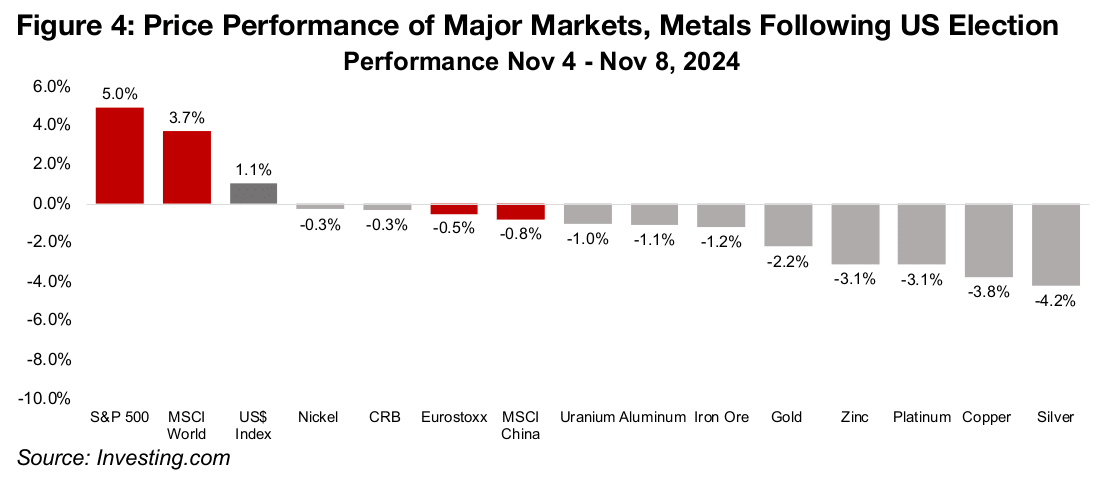
Potential US tariff hikes expected to hit global demand, metals markets
The Trump government is expected to make heavy use of tariffs and specifically
target countries where it views trade with the US as not fairly balanced. This appeared
to be the main reason for the hit to many major metals, with an effective increase of
prices for exports to such a major economy expected to weigh on global growth
overall. Also, there is the expectation that other countries could also react with
competing tariffs and this could drive up prices of many industrial goods further,
further dampening global economic demand.
A look at metals production by country shows where tariffs may fall most heavily on
the sector. While countries in the North American trading block, Canada and Mexico,
could receive preferential access to the US market, even they are unlikely to be totally
exempt from tariff increases, and countries outside this region could face more
pressure. This could partly explain the large declines in copper, silver, platinum and
zinc, which have a large proportion of their production from countries that could face
higher tariffs on their exports of these products to the US (Figures 2, 5, 6, 9).
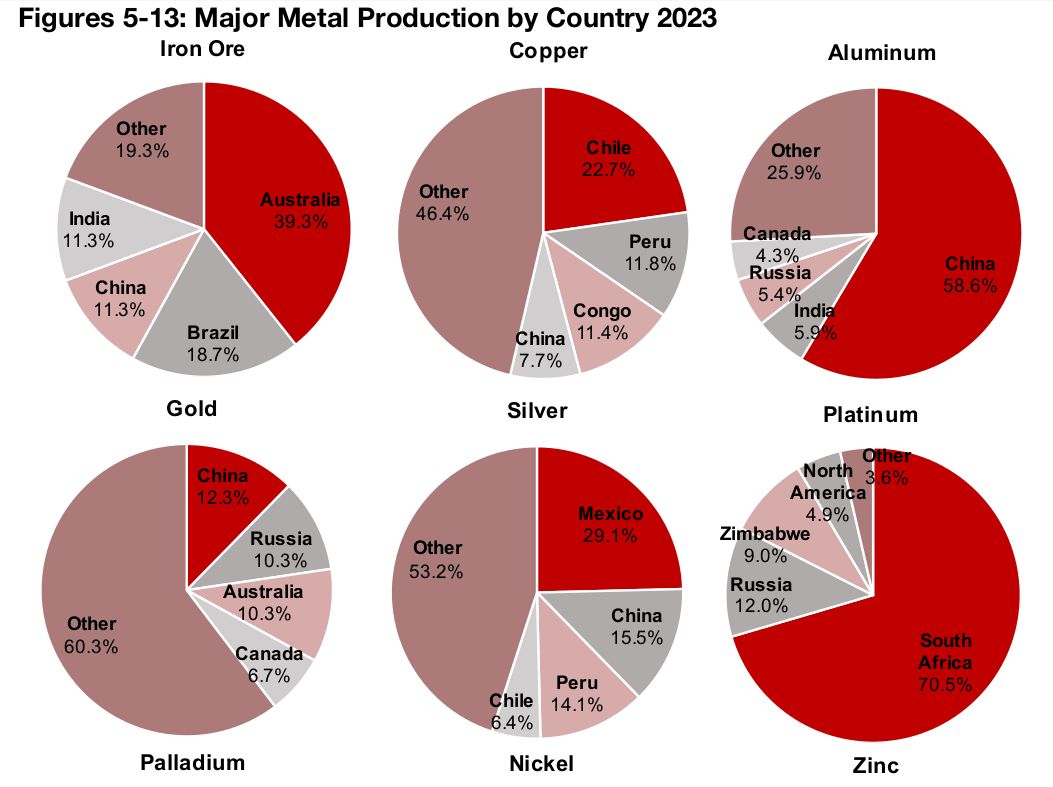

However, this does not seem to be the entire story, as several other metals, including
iron ore, aluminum and nickel (Figures 1, 3, 8), ranged from near flat to down about a
percent, even though they have a large proportion of production from countries
unlikely to receive favourable trade conditions from the US. Of three largest industrial
metals markets, iron ore, aluminum and copper, which are the bellwethers for
economic growth, only the latter faced a significant decline. This suggests that the
markets may not expect the Trump win and potentially heightened trade tensions to
heavily drive down broader global growth, but that they could cause issues that hit
some specific metals markets more heavily.
The gold decline was around the middle of the metals sector performance, with the
spot price down -2.2%, slightly more than the -1.9% drop in the futures price. Partly
this will have been driven by the rise in the US dollar and yields, with gold tending to
move inversely to both. However, there may also have been a decline in the risk
premium priced into gold, especially from rising geopolitical tensions, with
uncertainty greatly reduced given the increased clarity on the political direction of one
the world’s most influential countries. The previous Trump administration also
oversaw a period where there were far fewer major international conflicts than there
are currently, and the markets may expect more of the same starting next year.
US and Canada trade heavily intertwined
We expect that Canada may be able to gain relatively preferential trade conditions with the US, even given an overall likely tightening of restrictions, with the economies of the two countries heavily intertwined. Even through Canada’s economy is relatively small in the context of global giants like the EU or China, it is still the number one destination for US exports, at 17.0% of the total in 2022, and is the third largest source of US imports, at 13.6% of the total (Figures 14, 15).
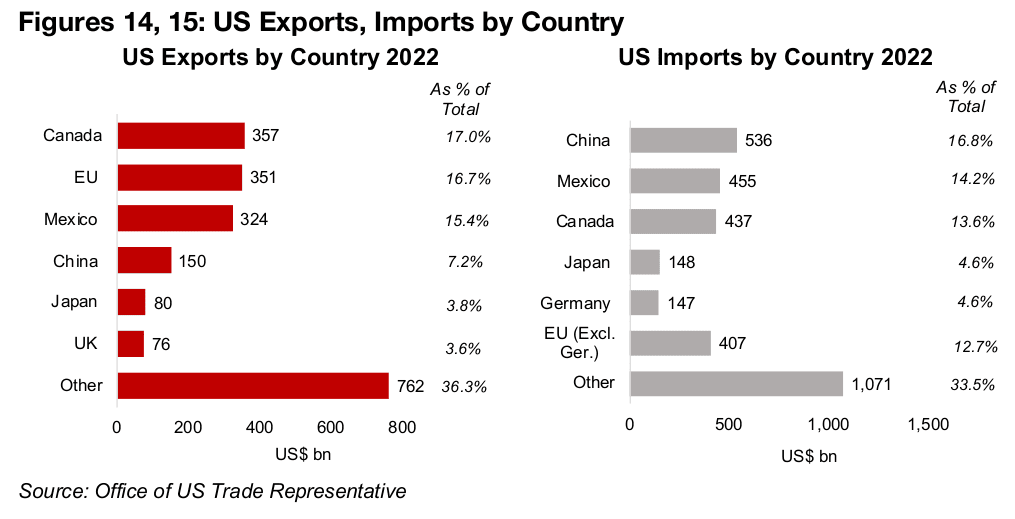
The US is also by far Canada’s largest trading partner, at 76.6% of exports and 48.3% of imports (Figures 16, 17). The countries therefore do have significant incentives from both sides, even though the US economy is far larger, to maintain amicable trade relations. This contrasts with China, for example, which is only the fourth largest destination for US exports, but the largest source of US imports, which could potentially see the US move to see this trade become more balanced.
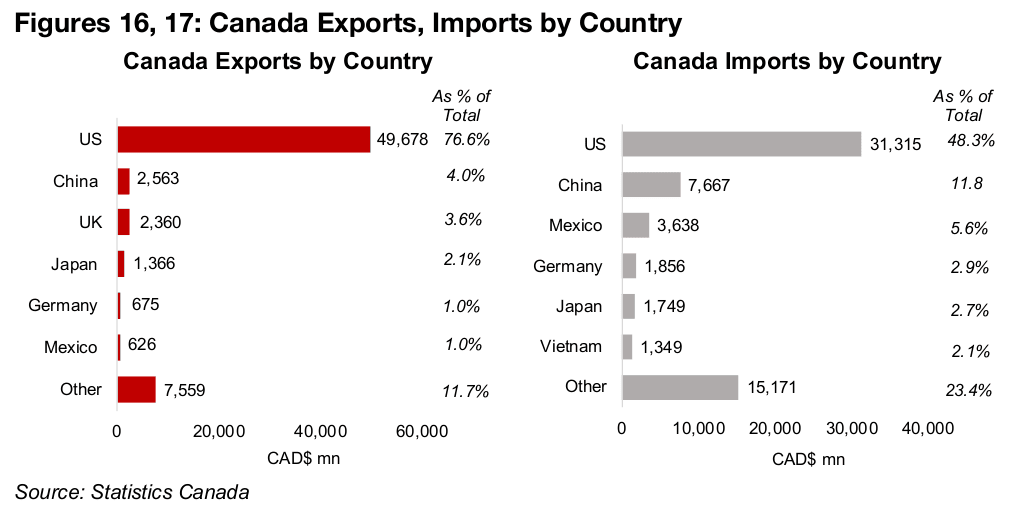
US a major market for Canadian mineral exports
For metals specifically, the US is a major market for Canadian exports. The two largest metal exports from Canada by value are gold and aluminum, of which the US accounted for 39.8% and 59.6% of the total in 2023, respectively (Figure 18). However, the US is not a major destination for all of Canada’s major metals exports, with iron ore exports 100% to other countries.
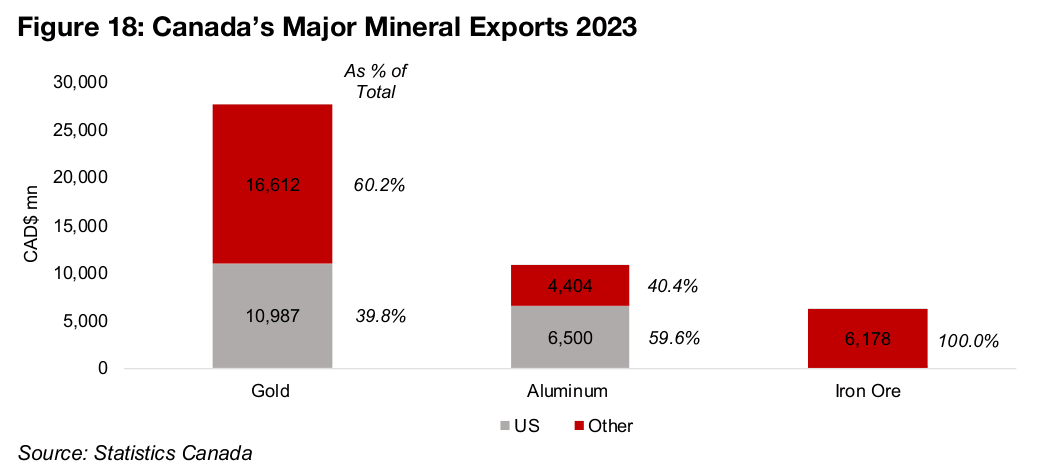
The proportion of US imports by metal shows a major contribution from Canada. For
gold, Canada accounted for nearly all US ore and concentrate imports, at 99%, and
was the second largest source of bullion imports, at 23% (Figure 19). For copper,
Canada was the second largest source of ore and concentrates, at 19%, and number
one for refined metal, at 62% (Figure 20). Canada was also by far the largest source
of US nickel and zinc exports, at 46% and 62% of the total and the second largest
source of silver imports, at 18% of the total (Figures 21-23).
The increases in US tariffs are more likely to fall on manufactured goods that compete
heavily with domestic production, with China specifically targeted by the new
administration. Canada’s metals exports to the US may be less affected, as there are
no major tariffs on gold imports and the large copper, nickel, zinc and silver imports
would likely all be considered critical to growth and less likely to fall under scrutiny.
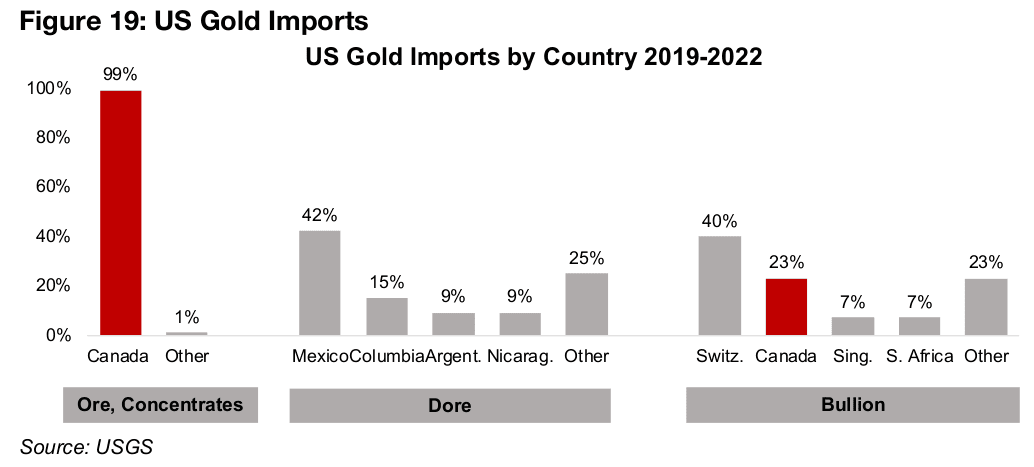

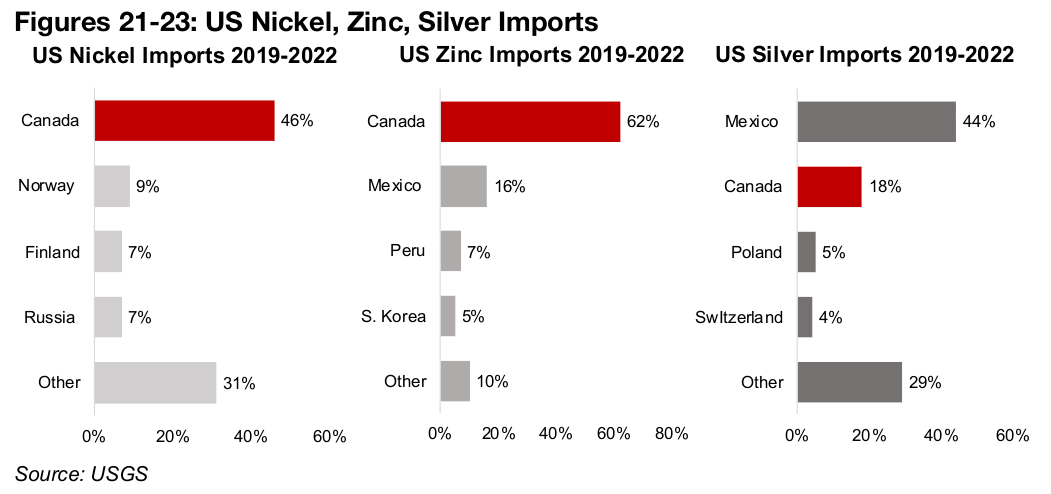
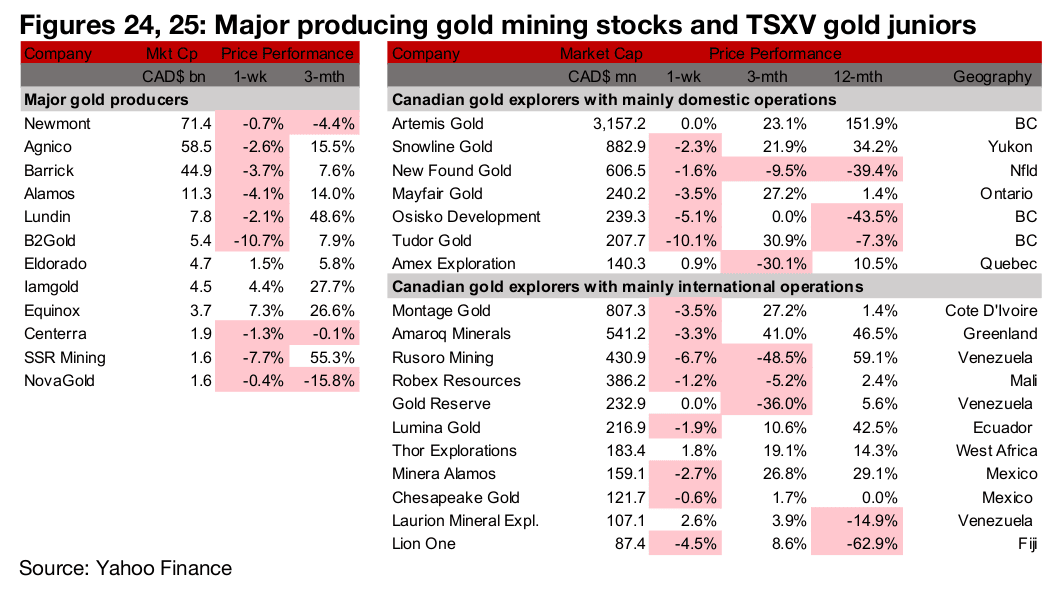
Large producers and TSXV gold mostly down
The large producers and TSXV gold were mostly down on the decline in the gold price (Figures 24, 25). For the TSXV gold companies operating domestically, Artemis reported Q3/24 results, New Found Gold announced the start of work on a maiden resource estimate and PEA for Queensway, Osisko Development reported progress in permitting for Cariboo and Amex Exploration reported drill results from Perron (Figure 26). For the TSXV gold companies operating internationally, Montage Gold started a revenue protection program through the purchase of gold put options (Figure 27).
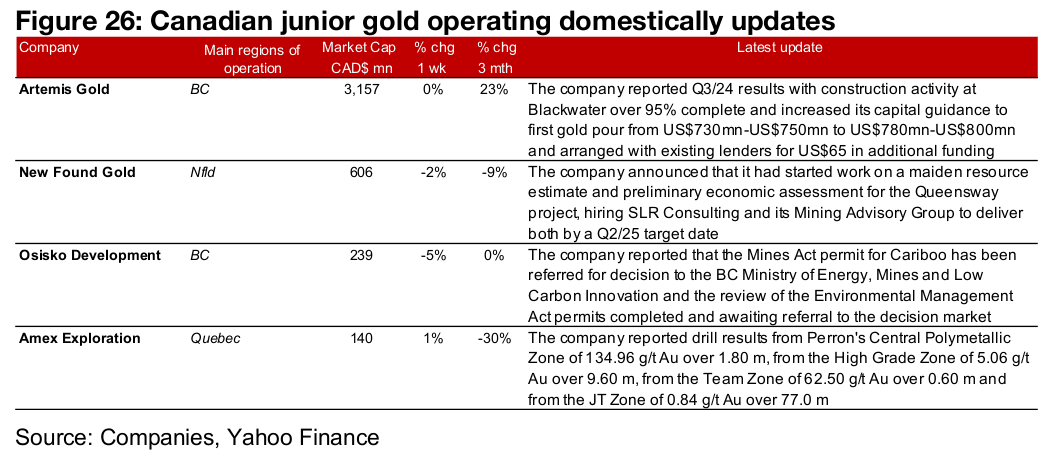

Disclaimer: This report is for informational use only and should not be used an alternative to the financial and legal advice of a qualified professional in business planning and investment. We do not represent that forecasts in this report will lead to a specific outcome or result, and are not liable in the event of any business action taken in whole or in part as a result of the contents of this report.


